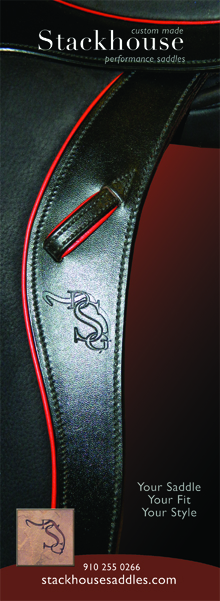Search the Site
The Fringe Eventer Blog Post # 11
Perfecting the Halt and Maximizing Your Score
You see, I started my mare so everything good and bad that she has learned under saddle can be linked directly to yours truly. And so it is with the halt. In the beginning, we lacked any form of steering whatsoever and yet I still made an effort to instill in her the three requisites for a halt; immobile, round, and square. I worked on each of these requirements, according to her ability, singularly in the beginning and starting with the idea of standing still. Slowly as she progressed I would add another step until voila, my mare considered a correct halt to be as normal and expected as being fed twice a day or loading quietly into a trailer. Over time I worked to refine the three basic requisites. Now, with very little prompting my mare will halt square, in the bridle, stand immobile, and keep her poll as the highest point of her neck. To this day, this is the last thing I ask of her before dismounting. Every. Single. Ride.
Why so picky you may ask? The way I see it, with so many ways to both gain and lose points in the sandbox why would you ever let the easy ones slip through your gloves?
So, here is how I earn those extra points.
Schmooze – I try to schmooze my mare into all of her transitions, especially the halt. You see, I am an impatient red-head. I lean towards reacting instead of planning. Hey, at least I’m honest. In the past, when my trainer has instructed me to transition from trot to walk I just did it without any forethought or preparation. Eventually I learned to schmooze, for lack of a better word, into my transitions. You call it preparing, I call it schmoozing. I like my word better, it just sounds like it feels.
Don’t think about the halt one stride out from X, or worse yet, one stride after X. Rather, you should be setting up for the halt as soon as you have turned down centerline. I have always tried to picture the last few steps going into a halt as if I were riding up a hill or into a trailer with a ramp in order to keep a forward feel and not slump into the halt. One thing I have learned, a correctly schmoozed and smooth halt will earn you more points than an abrupt one any day.
Front feet first – Now some may argue this point, but I’m going to stick to my guns. FYI, horses have four feet and trying to get all four feet, especially on a green horse, to line up square can make you nuts. At the USDF Regionals this year I saw many riders come into the halt and then try to get their horse to square up. Nine times out of ten they would try to fix a trailing hind leg. Inevitably they would shift their weight or apply a leg aid to cue the horse to step up and the horse would swing its haunches like a bell clapper. Pay attention to halts at your next show and I’m willing to bet that most horses you see will do the exact same thing. Usually it is a hind leg that trails.
Here’s what I learned. Where the front feet go, the back must follow. If you can get the front feet square and your horse is straight then the hind legs will be difficult for the judge at C to see clearly. One judge. One view. Use this to your advantage in the beginning. Let’s face it, how many times are most of us going to ride for more than one dressage judge? Championship classes, upper levels, and the like begin to introduce a side judge at either B or E. Worry about that later.
While practicing the halt at home a quick glance down at the shoulders will clue you in as to whether your horse is indeed square in front. In the beginning I even snuck a peek down at my mare’s legs. This helps you to develop feel. If the legs are off, then ask yourself, “Does my horse feel square beneath me?” Before long you will be able to feel what is beneath you.
Patience is a virtue – Now I know that many Thoroughbreds don’t know how to stand quietly. I think it is a matter of their DNA. They have been bred for centuries to run and of all the breeds I have ridden, it is the Thoroughbred that least understands the idea of immobility. If your partner is a Thoroughbred or just can’t seem to stand still for more than a nanosecond you definitely need to take your time, have patience, and build on the idea of immobility. Take it slow and reward often. Even if your horse will only stand still for a nanosecond at a time, try to stretch that nanosecond into a millisecond using tons of praise, and then eventually into at least three whole, complete seconds. Since I practice the halt at the end of every ride my mare is usually tired and thinks of the halt as “that thing before she gets off my back.” Use both of these to your advantage.
The directives for the halt in eventing are as follows; quality of halt, transition and immobility. The USDF test directives are willing, calm transition; straight, attentive halt, immobile (min. of three seconds – this was added for 2015). They are essentially the same.
The “front feet first” rule will improve the quality of the halt. Schmoozing should help you with your transition. And immobility, if you have been diligent in asking you horse to stand still for the halt should be the easiest of all. If you have been practicing the three requisites at home then meeting the directives should be easy.
As you move up the levels your horse will develop collection. With collection the hind end becomes more developed and the horse will begin to step under themselves more freely and naturally. Guess what? Since the hind legs follow the front and your horse is stepping up and under itself the problem of a trailing hind leg will usually fix itself.
The poll and the hind legs – I consider these to be the whipped cream and cherry on top of your perfect halt. Yes, the three requisites will get you good points, but keeping your horse’s poll as the highest point and being able to square up the hind legs consistently are what will really give you an edge over other competitors. Not only that, but they are oh so important building blocks for truly correct dressage. The hind legs can be taught to square up before collection has been achieved, but if your horse is still swinging and struggling with squaring the hind end then focus on fixing the poll instead. This will be especially difficult for horses that tend to curl behind the bit. Remember, one thing at a time. Rome wasn’t built in a day. Dressage and riding in general is a series of building blocks.
I have taught my mare to respond to a light, even squeeze from both legs in the halt. This pushes her into the bridle and lifts her poll. If your reins are the correct length, which they should have been from the moment you entered the arena at A, then the nose should be at or just in front of the vertical at the halt. If your horse tends to raise its head, then you may need to squeeze the inside rein lightly and ask your horse to lighten and lower its head. Keep in mind, your cue for getting your horse to soften and lower its head may differ from mine. The important thing is to speak in a language you and your horse understand.
I found a very interesting and eye-opening article online by Colonel Christian Carde. In the article he reiterates the key elements of the halt according to the FEI Rulebook.
- 1. At the halt, the horse should stand attentive, engaged….and square with the weight evenly distributed over all four (4) legs. The neck should be raised with the poll as the highest point and the nose slightly in front of the vertical. (…) The horse may quietly chew the bit and should be ready to move off at the slightest indication of the athlete.
- 2. The halt is obtained by the displacement of the horse’s weight to the hindquarters.
If you are in doubt as to the importance of the halt I suggest you read his article, which was posted on eurodressage.com. It highlights the lack of good quality halts in Grand Prix dressage. http://www.eurodressage.com/equestrian/2014/08/06/christian-carde-where-did-halt-go
So, imagine if you will that you are able to not only fulfill the directives of the halt, but that your horse is square behind and the placement of the poll and nose are correct. If you have a judge that is bored stiff from watching incorrect or just plain bad halts for hours on end you just may wake them up and in turn earn those extra points that will make all the difference in the end.
*So this is where I insert a disclaimer. Please do not think I advocate a halt that is not square. I most certainly do not. In the end you should always strive for a halt that is smooth, straight, square, forward, and with the poll correct. These will all be achieved with time, proper training, and patience. What I am saying is that if you are being judged and your horse has a hind leg trailing, but is straight and the front legs are square then you need to make the decision as to whether or not to fix the hind leg and risk ruining what you already have.
This video is from the 2014 USDF Area 3 Regional Championships where we scored a 9 from the judge at B. She was in the ideal position to see all aspects of our halt. I was so very relieved to have the stress of competing at Regionals behind me that unfortunately I took my leg off for a millisecond and my mare lowered her head for a moment. Perhaps if she would have stayed in the bridle we could have earned a 10.







0 Comments Posted Leave a comment